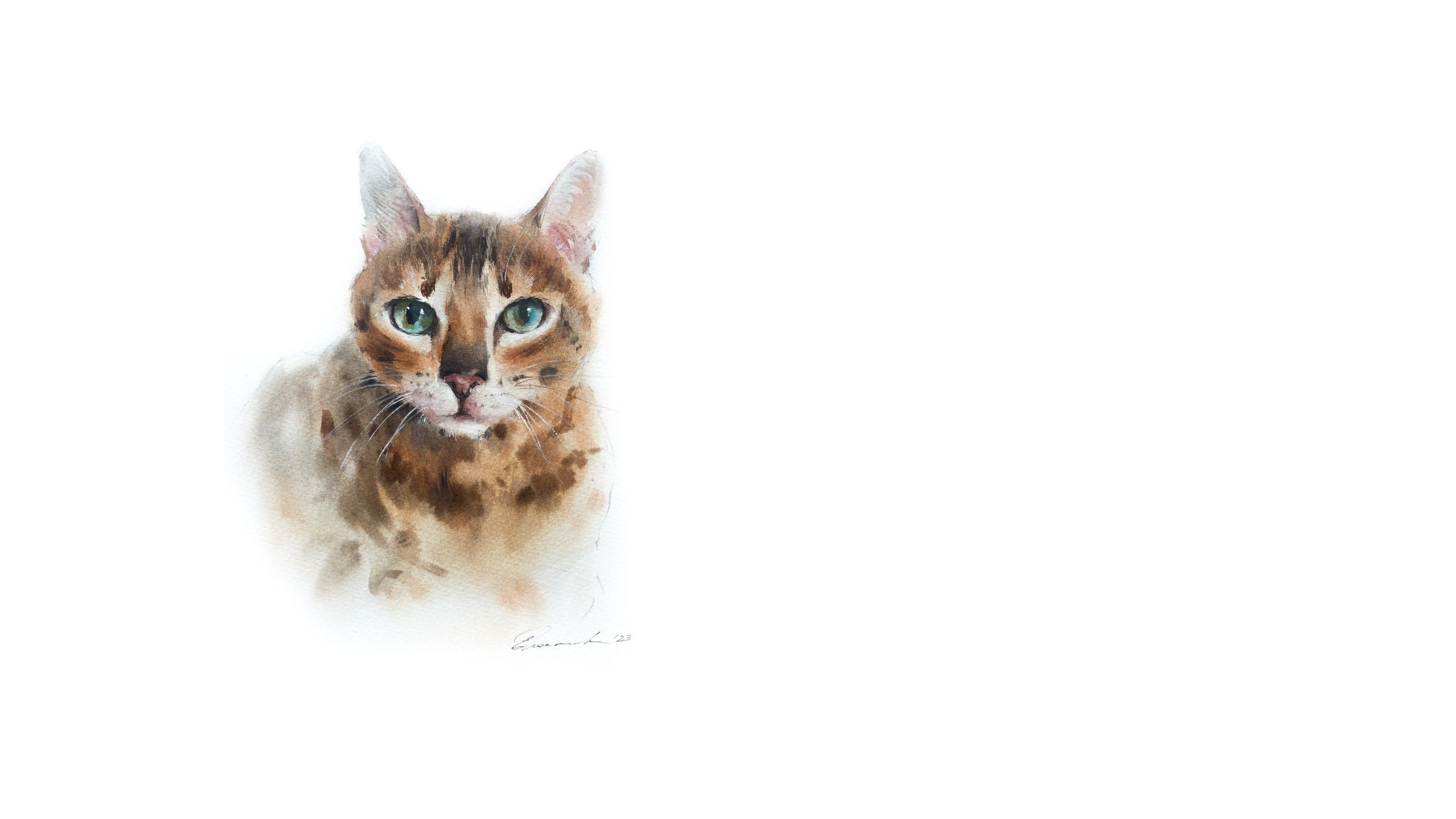Do you like to listen to the quiet purring of cats,
to stroke their fluffy fur,
to play with soft tender paws?
Sure you do! Everyone loves cats
and they respond to us in return,
filling our lives with kindness and affection...
Content
A little bit of cats anatomy.
First, we'll talk a little about the importance of understanding the construction of the object you're drawing.
We will consider the structural features of the cat's skeleton, pay attention to the design of the eye and dwell in more detail on the proportions of the muzzle.
You will learn how to:
- start work after analyzing the anatomy of nature;
- pay attention to the preparatory stage.
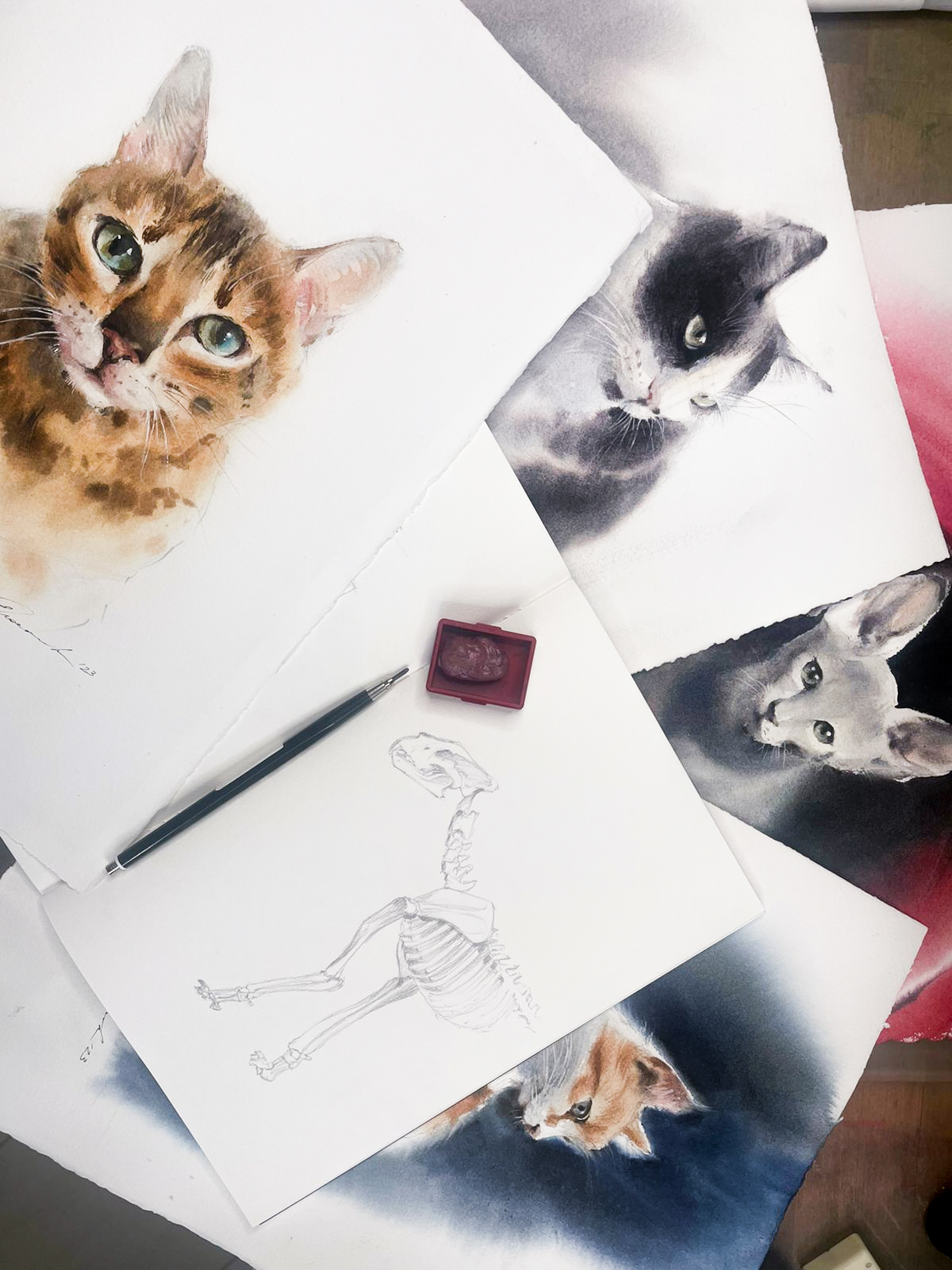
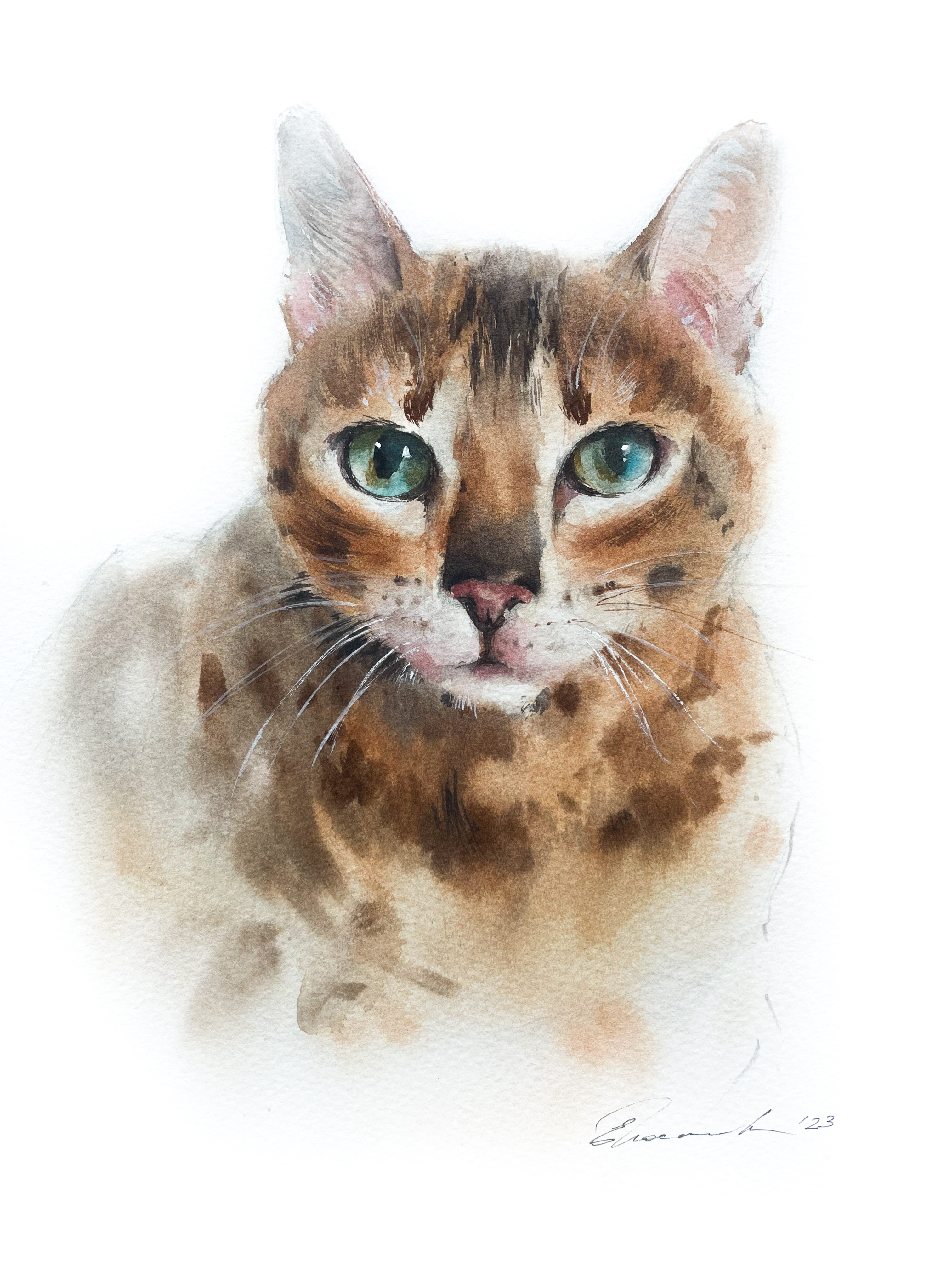
Lesson 1. Cat portrait
In this tutorial we will apply knowledge about the features of the skull and proportions in the frontal portrait of a Bengal cat. The heroine of our story is affectionate and tender and we will try to capture this character and convey it in our work.
In this tutorial we will use layered fills and dry sheet technique.
You will learn how to:
- make a portrait, emphasizing the features of the model, but not copying every spot of color and not being tied to the contours;
- highlight the main thing in the portrait;
- pay attention to textures;
- create a watercolor drawing, maintaining lightness and courage.
Lesson 2. Kitty in profile.
This time we have a slightly wild model, there is something subtly foxy in it! She is a huntress, warily looking somewhere.
In this tutorial we will depict a cat in profile and in full growth, add watercolor fluffiness to the image, doing work on a wet sheet. Emphasize the glow of white fur with a contrasting bold background.
You will learn how to:
- freely interpret the reference;
- create an artistic image of the model;
- work with fluffy nature in the technique on a wet sheet moistened on both sides;
- feel the balance of water on the brush and the degree of moisture content of the paper;
- feel free to use a contrasting background, revealing the nature of the character.
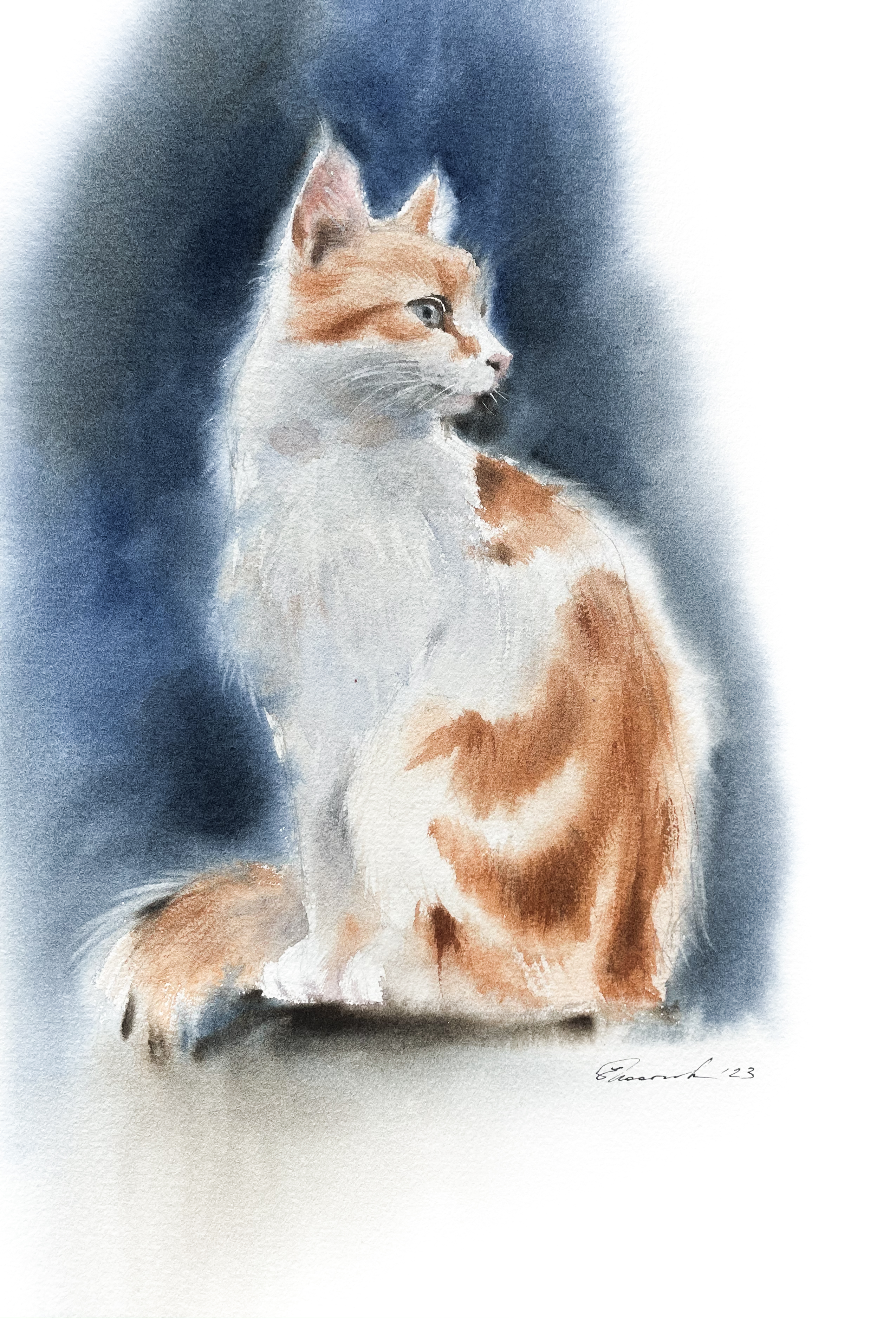
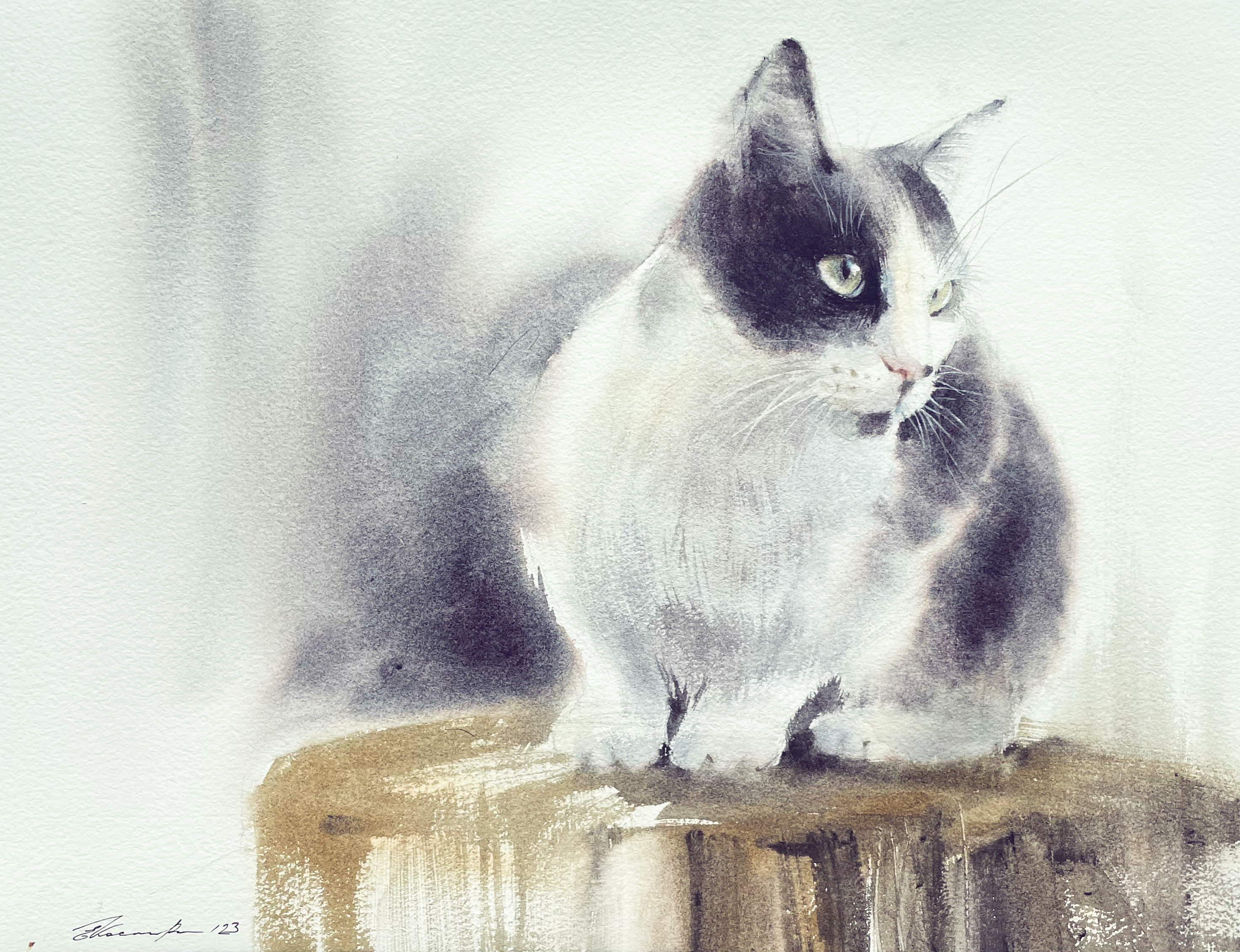
Lesson 3. Night hunter.
Having studied the object, we will convey the character of our new character. Here we a real hunter who perfectly catches mice and at the same time generously gives his affection to the owners. Wise and kind.
Technically, the work will be done on a wet sheet with a delicate use of the background. In this lesson, we depict a more complex view of the muzzle - 3/4, take into account perspective cuts and follow the correct arrangement of paired forms.
You will learn how to:
- pay attention to the study of the object;
- carefully approach the image at the drawing stage;
- analyze the design of the model without copying the external contours from the reference;
- depict the model in a more complex perspective, taking into account perspective cuts in the form;
- mix pigments to get black and white color.
Lesson 4. Sweet couple.
In this lesson we will work with a smooth-haired oriental breed, which has its own features and proportions. There will be two characters at once, two kittens! For inspiration we'll use a photo from the Cat Fanciers' Association 1995 catalog, which collected the best representatives of the breed at that time.
Our task is to create a cute image inspired by photography, express the velvety of wool with watercolors and make a smooth work using a bright contrasting background.
You will learn how to:
- look for inspiration without using digital sources;
- to work on two main characters;
- analyze the proportions;
- depict the velvet texture of smooth-haired cat breeds;
- work with a background that is contrasting and saturated in color and tone;
- pay attention to reflections and edges of the depicted models.

This course is dedicated to purring pets, fluffy and smooth-haired, with different characters and colors.
We will draw several angles:
🔸frontal,
🔸 profile,
🔸 3/4.
We will understand the cat anatomy and, taking into account the patterns, we will create watercolor images using various techniques - both on a wet sheet and on a dry one.
From a watercolor without a background we will move on to a subject with a rich
and a contrasting background component!
Purrrfect course for those who want to:
🔸 be able to analyze nature and highlight the main thing in the anatomy of an object,
🔸 be not afraid to draw animals, especially cats,
🔸 be able to generalize and identify the main thing, and not copy,
🔸 add more freedom to drawing,
🔸 learn expressive watercolor technique.
What is the online course procedure?
🔸 After payment, you will be enrolled in the course and receive the material
🔸 The duration of access to the lessons will depend on the format of your training - 1, 3 or 6 months
🔸 After opening the video lessons you can watch them at any time convenient for you
What VIP format with feedback from Eugeniya Kostikova includes?
🔸 Access to video lessons for 6 months
🔸 Tasks checking during 1 month
🔸 Full comments on your works from the teacher
🔸 Work on errors
🔸 Teacher recommendations
🔸 Possibility of individual consultation
ARTIST
Eugeniya Kostikova
Hello dear friends!
My name is Evgeniya Kostikova, I am a watercolor artist and teacher of fine arts.
I live and work in Russia, in Tula. Being an architect by education, I've been in love with watercolor since my studies. However, first time I discovered all the diversity of the world of watercolor was only when I got the opportunity to buy professional materials and learn from famous artists.
In my work I experiment with different watercolor techniques, allowing the paint to play freely on the sheet and make adjustments to my idea.
The main source of my inspiration is nature. Approaching the beauty of the world around us, capturing states, conveying on paper the wind, summer midday heat or frosty winter morning, presenting the viewer with my emotions from communicating with nature - this is how I see the main task for myself as for an artist.
Since 2018 I have been actively teaching, painting with children in my studio, conducting a full-time watercolor course for adults, plein-airs and workshops.
At the moment I am a member of the International Watercolor Society, a member of the Union of Professional Artists of Russia, as well as a participant and winner of international watercolor exhibitions and festivals. My works are in private collections in Russia and abroad.

Works by Eugeniya Kostikova
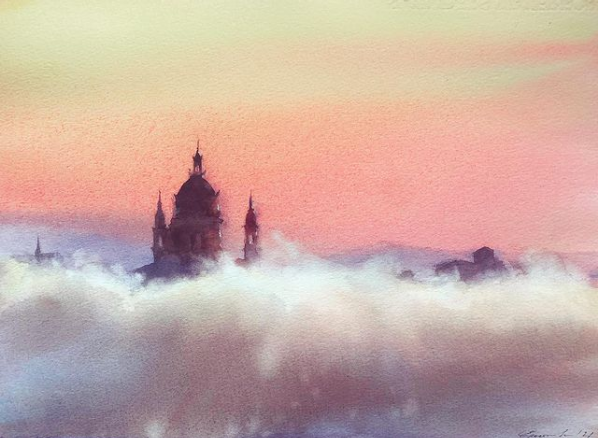
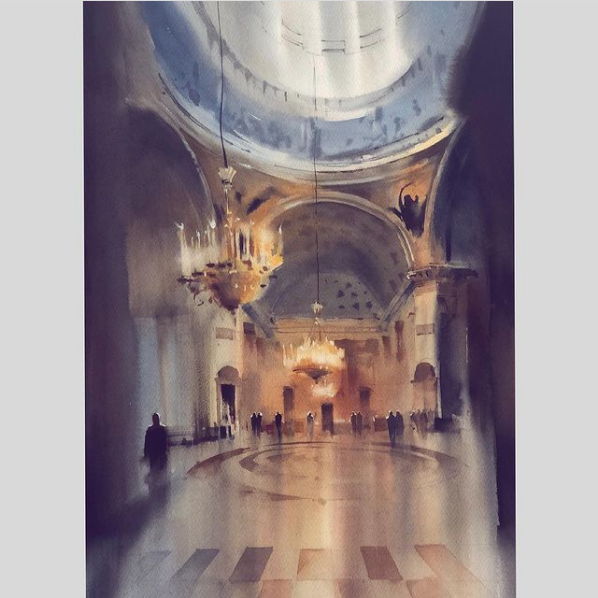

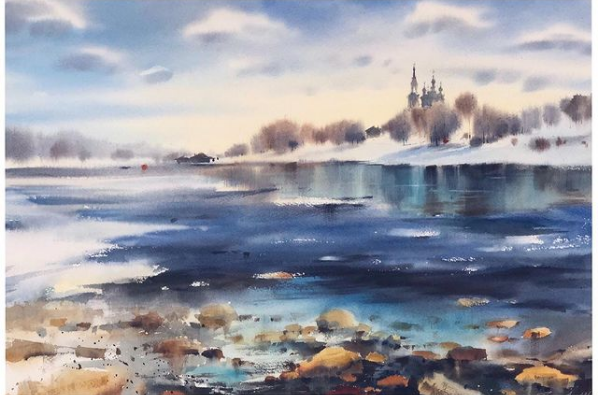

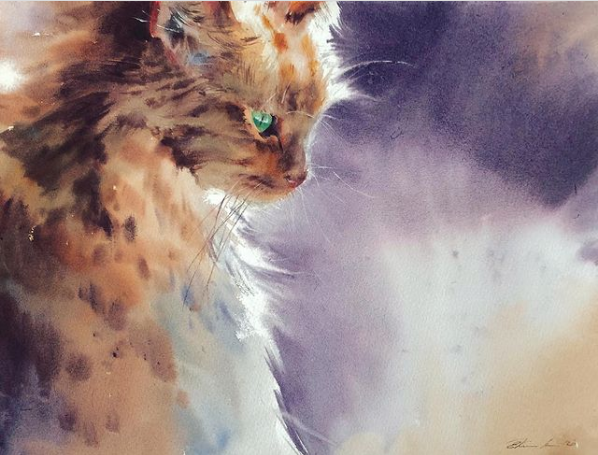
Materials:
Paper: Lana, Hahnemuhle Cezanne, SaundersWaterford 100% cotton, 300 g/m2, medium grain, sheet size 28x38 cm (quarter sheet and smaller).
Brushes:
- goat flute brush (I use Herend brushes)
- filling brush with a sharp tip with a squirrel-mix pile (French attachment) Pile width of about 6 mm. (I use Belka brushes)
- sharp-tip synthetic brush number 6 and number 2 for finer details (Roubloff Aqua blue, Escoda Perla)
- flat brush with chipmunk hair (Herend), width 8 mm, can be replaced with a flat brush with synthetic hair.
- Chinese calligraphic brush (weasel/wolf pile)
- flat brush (squirrel pile or synthetic), number 16
- any fluffy dry brush (squirrel, imitation squirrel)
Additional materials:
Plexiglass or plastic plate slightly larger than the size of the sheet, masking tape, HB black crayon, blotter, paper towels, palette (you can use a white ceramic plate), two containers of clean water, spray gun.
Paints:
Manufacturers can be different. In my palette mostly pigments from the Nevskaya Pallitra series White Nights.
- Neapolitan light yellow (PY 216)
- Ochre yellow (Daniel Smith), you can replace it with Neapolitan yellow.
- Cadmium orange
- Pink quinacridone (carmine or any cold red)
- Crimson (cadmium red, geranium, or any warm red)
- Sienna burnt
- Sepia
- Amber burnt
- Dark ultramarine
- Cobalt blue
- Indian blue (can be indigo, Van Gogh grey)
- Ceruleum Van Gogh
- Shadow Violet Daniel Smith (optional)
+ gouache - titanium whitewash.
I recommend making coloring in advance, mix the right pigments with each other before you start.
